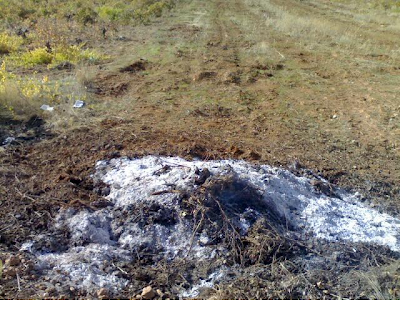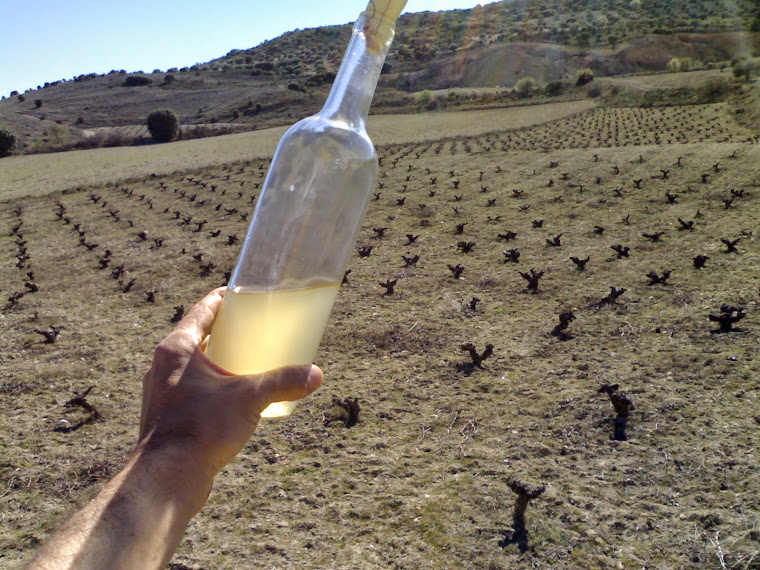Last Wednesday 9th November I went out to check on the vineyard at Villarejo. This is our 'new' vineyard that we took on last year and which we harvested for the first time a few weeks ago (see this post). White Malvar variety, old vines, about 40-60 years old I think.
 |
| View (1) of Villarejo Vineyard |
There wasn't much for me to actually do, so I just wandered around looking at the vines, and soil and plant cover.
 |
| View (2) of Villarejo Vineyard |
The leaves haven't fallen off yet, which means that the vines haven't entered their dormant phase over the winter, and that the sap is still flowing.
 |
View (3) of Villarejo Vineyard |
I noticed that most of my neighbours have already pruned their vines:
 |
| Neighbour's Vineyard pruned Already |
I think it's a really bad idea to prune vines before the leaves fall off, because you're removing sap and nutrients before the vine has had time to store them down in the roots and trunk. The vine needs to use these nutrients to produce its first leaves in spring, before the leaves are mature enough to do photosynthesis and produce energy for growth.
 |
| Neighbour's canes piled up at edge of his vineyard |
Maybe it's not that critical, because a vine won't actually die if you prune it too early! But on the other hand, it won't be as healthy and vigorous as it could be if you gave it the benefit of using all available sap and nutrients; and maybe in the long run, if you prune too early every year, you could shorten its lifespan, as the losses are cumulative.
I think it's also a bad idea to remove the canes from the vineyard. In my opinion, it's better to chop them up as small as possible and scatter them among the vines. This is good organic matter that will help improve the structure of the soil.
 |
| More neigbour's canes - ready for removal |
I can't think of any possible advantage to pruning so early, as far as vine and grape quality, and health and vigour are concerned. The only possible 'advantage' could be one of convenience, ie the grapegrower has other crops and other tasks to do, and wants get the pruning out of the way as soon as possible!
I was shocked and horrified, and angry and fustrated (all at once!) to see that our immediate neighbour had uprroted his vineyard and burnt the trunks. He must have done it the day before because the pile of ash was still smouldering.
 |
| Neighbour's ash smouldering |
If only I had known before, I could have spoken to him and maybe reached an agreement to rent the vineyard from him. Personal reasons apart, I think it's a tragedy on a cultural, agricultural and social level to uproot/destroy old vines. They're part of everyone's heritage and history and culture.
Another neighbour, on the other side of the uprooted one, didn't bother to harvest his grapes this year!
 |
| Neighbour's unharvested grapes |
I tasted a few, and surprisingly, they were still hale and healthy, and very sweet. While wandering around my own vines I came across a crate that we must have forgotten there during the harvesting, so I made use of it, and stole a few bunches of grapes from the neighbour! I'll confess if I ever meet him! In fact, I should really make an effort to find him, and speak to him about renting his vineyards, before he decides to uproot it too!
Bodega
Then I went to the bodega in Morata de Tajuña, to wash some bottles. We ask all our local customers to return our wine bottles to us. We then de-label them, wash and sterilze them, and reuse them.
I was supposed to do this task last weekend, but I had a cold and was feeling awful, and stayed in bed for 2 days instead!
In the end, I didn't do any bottle-washing as such - just soaking and de-labeling, in preparation for the actual washing tomorrow or the next day.
 |
| Bottle-soaking station |
The stainless steel tank was full of water with an oak barrel immersed in it! It's an old barrel that we're rehydrating so we can use it in the future. Anyway, I used the water to fill the buckets for soaking the bottles, thereby 'saving' a few hundred litres of water.
 |
| Close-up of wine bottles getting their labels soaked off |
The great majority of the labels come off relatively easily after only about one hour of soaking. A few though are just impossible, no matter how long you leave them soaking. Some labels are 'plastified' and so can't absorb any water, and some use super-strong adhesive.
Well, there are now about 500 de-labelled bottles ready for 'processing'. I hope to see you all at the bodega this Saturday and/or Sunday. Lunch and wine included! :)
Lastly, if you're following me on FaceBook and Twitter, you'll know that our clay amphora (in which we're making 200 litres of an experimental 'orange' wine) was leaking. Well, I think it's reached an equilibrium state, because it's not leaking worse, ie the damp marks on the walls of the amphora are just the same as last week; just damp, no actual liquid coming through.
More lastly, I tasted our Airén 2011 from Carabaña, and was very pleasantly surprised. I took a glass from the bottom of the tank, and it was crystal clear! Not cloudy at all. There was a whiff of an 'off' 'closed' smell (sorry, I don't know the technical term for it!) but it was volatile and disappeared almost immediately. I think this will disappear with a bit of airing at bottling, or a racking if necessary. The aromas and tastes were very intense, more than last year.
And finally lastly, some winery activities that you're all welcome to come along to:
Apart from bottle-washing:
- Bottling the Airén 2011
- Bottling the coupage (60% Tempranillo, 20% Graciano, 20% Sirah)
- Making orujo (grappa, marc, pomace brandy)
If anyone's interested, contact me either on my mobile (697-050-010) or by email enestoslugares@gmail.com for the details, ie date, time, where to meet, etc.

